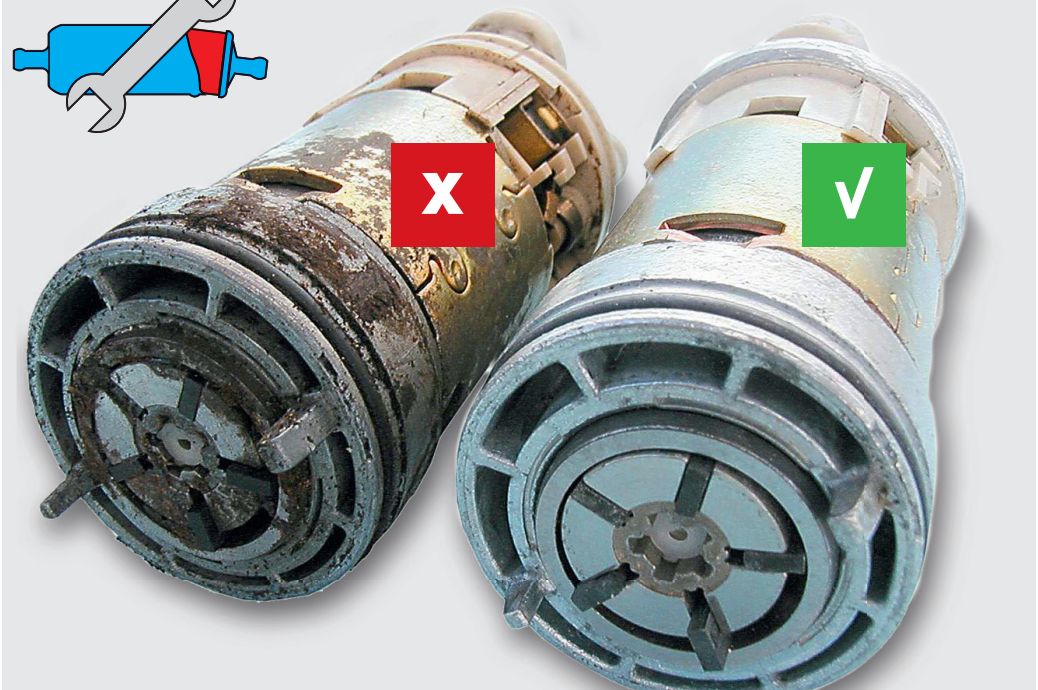
Fault diagnosis
Electric fuel pumps
What is the most common damage caused to fuel pumps? Why do electric fuel pumps often break? What could have gone wrong when installing the fuel pump that means the tank indicator no longer works? How can you tell from the outside that the pump is damaged? You can find an overview here.
MAIN CAUSE: DIRT
A frequent cause of malfunctions in the fuel system or of premature failure of fuel pumps are large or small particulate impurities. They have different effects:
- Clogged filters
- Reduced flow rate
- Fuel pump is excessively noisy
- Pump runs dry
- Jammed pump system
If aspirated foreign bodies enter the fuel pump, the rotating parts of the pump system are often jammed. The pump then often fails immediately.
Here are some possible causes:
- Dirt is getting into the fuel tank when filling.
- Rust or lime particles (“water damage”)
- Fuel ageing (formation of deposits after long stoppages)
- Maintenance intervals (filter replacement) not complied with
- Poor fuel quality (incorrect fuel, E10, biodiesel etc.)
- Old, porous fuel hoses
- Damaged fuel sieves on intake side
INSTALLATION ERROR/IMPROPER HANDLING
Improper mounting or removal of a fuel pump can result in damages to the gasket, housing or to the connections (electrical system, fuel).
- Electrical connections can be damaged or break off.
- The hose connections may tear or break off.
- Filters and any ribs in the filter can be damaged. Dirt can penetrate or fragments of ribs in the filter can jam the pump system.
Contact corrosion:
Improper mounting or retrofitting can result in material combinations being used that trigger contact corrosion, e.g. steel clamps with a zinc coating and no insulation mounted directly on the aluminium body of the pump. In the worst case, the pump body can leak due to pitting corrosion.
DAMAGE IN TRANSIT
Damage in transit is generally easily recognisable: Outwardly visible signs include bumps, dents, dirty intake or outlet nozzles and broken connections and fittings. Not visible: If a fuel pump is dropped when mounting, the permanent magnet that runs around the outside of the rotor can crack and fragments can jam the pump.
All fuel pumps undergo quality controls and function checks in the plant before delivery. Damage such as this could only have occurred later as the result of improper handling.
Our tip: Only remove packaging and transport closures, such as padded film and plugs in new fuel pumps, immediately before installation.
WATER DAMAGE (CORROSION)
Water in the fuel can lead to lime precipitation or formation of rust. If significant rust or lime deposits develop, they can jam the rotating parts of the pump system, just like aspirated foreign bodies.
Rust or lime particles can clog filters and thus lead to dry running.
Causes of water in fuel:
- Splash water can get into the fuel system in numerous ways, e.g. due to a leaky or missing tank-cap seal, a missing fuel tank cap and through ventilation orifices in pneumatic valves that are exposed to splash water (e.g. valves in the activated carbon filter system).
- When vehicles with a relatively empty fuel tank are not driven for longer periods, the large quantity of air in the tank means that a larger volume of condensation can build up.
- High alcohol content in fuel: Alcohol is hygroscopic, i.e. it binds water to itself. When a certain limit value is reached, this water is shed.
If rust or lime deposits are visible on the intake side of a fuel pump, this is a sign of water in the fuel.
DRY RUNNING: CLOGGED FILTERS
Modern fuel pumps are flushed through with fuel, which lubricates and cools them. If this is not done to a sufficient extent, there is a risk of dry running. Dry running very quickly leads to damage in the pump system.
Symptoms can be a reduced delivery rate, insufficient pressure, excessive operating noise from the fuel pump or even engine misfires or failure of the fuel pump.
Possible causes include:
- A range of fuel pumps have an integrated sieve filter on the intake side to protect against impurities. These sieve filters can be clogged by impurities.
- Squeezed or kinked lines on the intake side reduce the flow.
For this reason, fine-mesh filters must never be fitted on the intake side. This is why the fuel filter is always on the thrust side
INCORRECT TANK INDICATOR DUE TO FITTING ERROR
Modern saddle tanks often contain components, e.g. suction jet pumps and lines, directly in the fuel tank. If a fuel delivery module is incorrectly installed in the fuel tank, the fluid-level sensor may get caught on these installed components. This results in a tank indicator errorr
Product groups
This might also interest you



